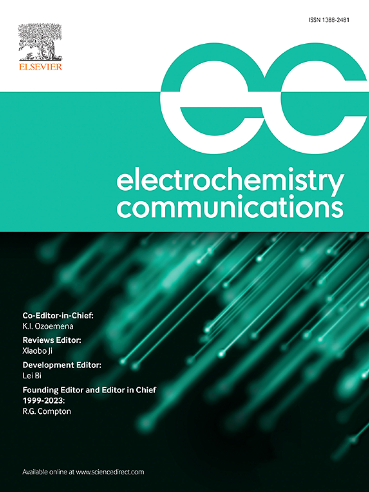Co9S8@CNFs cathode enables stable aluminum storage with 3D synergy and co-dominated mechanism
IF 4.2
3区 工程技术
Q2 ELECTROCHEMISTRY
引用次数: 0
Abstract
Rechargeable aluminum ion batteries (AIBs) hold promises as the next generation of electrochemical energy storage systems, characterized by low cost, high specific energy, and enhanced safety. One of the primary obstacles hindering the development of AIBs is the scarcity of suitable cathode materials. Here, a novel cobalt sulfide@carbon nanofibers (Co9S8@CNFs) composite material was synthesized through electrostatic spinning, heat treatment, and sulfurization processes. The composite material consists of Co9S8 nanoparticles uniformly anchored on interconnected CNFs to form a three-dimensional (3D) porous network structure, which is conducive to the penetration of electrolyte. Structural and morphological analysis confirmed the high crystallinity of Co9S8 and its uniform distribution on CNFs. The in-situ growth of Co9S8 nanoparticles on the surface of CNFs helps shorten the migration path of electrons and effectively solves the problem of peeling off from the CNFs substrate during charging and discharging process. As a self-supporting cathode for AIBs, the electrode exhibits good cycle life. Electrochemical evaluation demonstrated a reversible discharge capacity of ∼60 mAh g−1 at 100 mA g−1 with stable cycling performance over 400 cycles. The composite cathode exhibited small charge transfer resistance and improved ion diffusion kinetics, attributed to the conductive CNFs network and 3D porous structure. First-principles calculations further elucidate the energy storage mechanism, revealing that Al3+ preferentially replaces Co atoms in the Co9S8 lattice during cycling, with a formation energy of 0.92 eV. This work emphasizes the synergistic effect of Co9S8@CNFs integration in alleviating rapid capacity degradation and enhancing structural stability, providing a promising strategy for designing high-performance AIB cathodes.
Co9S8@CNFs阴极使稳定的铝存储与三维协同和共同主导的机制
可充电铝离子电池(AIBs)具有成本低、比能高、安全性强等特点,有望成为新一代电化学储能系统。阻碍阴极材料发展的主要障碍之一是缺乏合适的阴极材料。本文通过静电纺丝、热处理和硫化工艺合成了一种新型钴sulfide@carbon纳米纤维(Co9S8@CNFs)复合材料。复合材料由Co9S8纳米颗粒均匀锚定在相互连接的CNFs上,形成三维(3D)多孔网络结构,有利于电解质的渗透。结构和形态分析证实了Co9S8的高结晶度及其在CNFs上的均匀分布。Co9S8纳米颗粒在CNFs表面原位生长,缩短了电子的迁移路径,有效地解决了CNFs衬底在充放电过程中脱落的问题。作为aib的自支撑阴极,该电极具有良好的循环寿命。电化学评价表明,在100 mA g - 1下,可逆放电容量为~ 60 mAh g - 1,循环性能稳定,超过400次循环。复合阴极由于具有导电性的CNFs网络和三维多孔结构,具有较小的电荷转移阻力和更好的离子扩散动力学。第一性原理计算进一步阐明了能量储存机制,揭示了Al3+在循环过程中优先取代Co9S8晶格中的Co原子,形成能为0.92 eV。这项工作强调了Co9S8@CNFs集成在缓解快速容量退化和增强结构稳定性方面的协同效应,为设计高性能AIB阴极提供了一种有前途的策略。
本文章由计算机程序翻译,如有差异,请以英文原文为准。
求助全文
约1分钟内获得全文
求助全文
来源期刊

Electrochemistry Communications
工程技术-电化学
CiteScore
8.50
自引率
3.70%
发文量
160
审稿时长
1.2 months
期刊介绍:
Electrochemistry Communications is an open access journal providing fast dissemination of short communications, full communications and mini reviews covering the whole field of electrochemistry which merit urgent publication. Short communications are limited to a maximum of 20,000 characters (including spaces) while full communications and mini reviews are limited to 25,000 characters (including spaces). Supplementary information is permitted for full communications and mini reviews but not for short communications. We aim to be the fastest journal in electrochemistry for these types of papers.
 求助内容:
求助内容: 应助结果提醒方式:
应助结果提醒方式:


